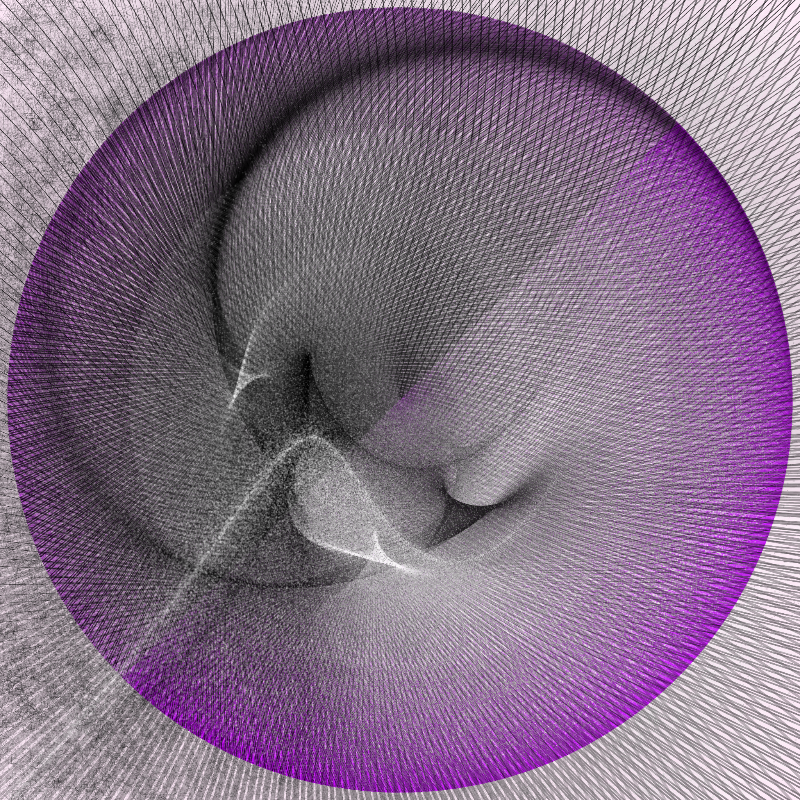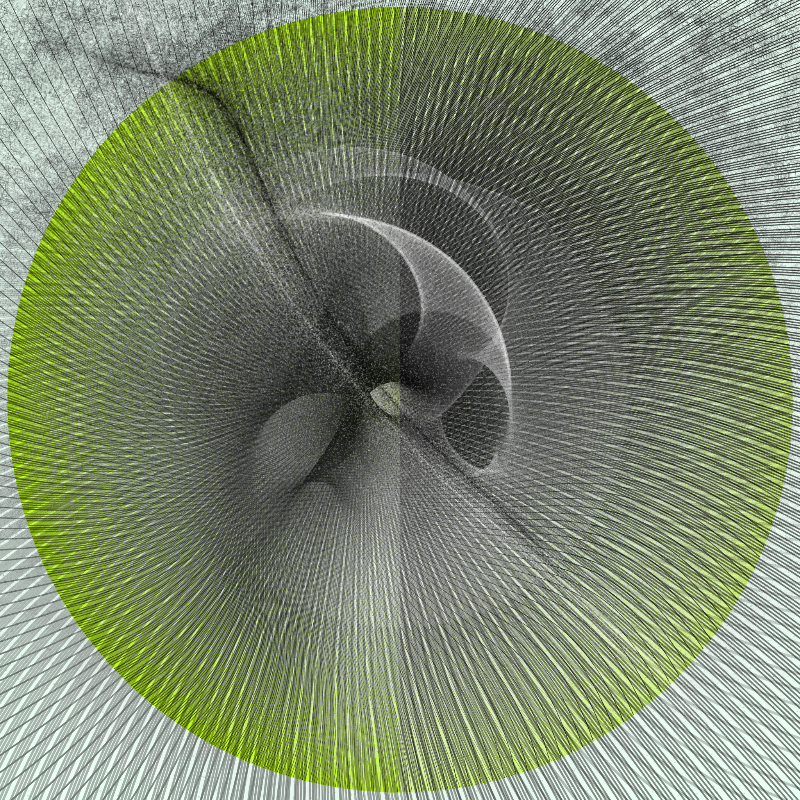Aurae
IPFS

1 January 2023•TEZOS•IPFS
A Bézier curve is a type of curve defined by a set of control points. It can be thought of as a smooth curve that is pulled towards these control points, with the shape of the curve being determined by the positions of these control points. If the positions of the control points are changed in some way, the curve will alter to follow these changes.
The piece comprises multiple layers:
The main layer is a set of rippling Bézier curves, formed as the control points move along their own curves, traversing this path through a full rotation of the canvas. By plotting more than one of these curves, Moiré patterns emerge, further enhanced by altering stroke weights and line density as the piece progresses. Additionally, a pattern of on/off values is formed, of varying length, leading to a repeated pattern of gaps and lines.
A second layer is added: beneath these curving, sinuous lines, points are plotted close to the limit of a circle, nearly filling the canvas. Its edges coincide with one of the points of the curves, producing an eclipsed planet; the lines seeming to dip behind its horizon.
A third layer: a textured monochrome background, partially obscuring a plain-coloured canvas that forms the base of the piece. This adds interest to the canvas, though the effect is subtle and mainly seen towards the edges of the piece.
A final layer is two sparkling, dancing lines that move around or across each other, sometimes intertwining, sometimes dramatically parting. These lines follow the midpoints of the lines created in the first layer, shifting along the lines as the piece progresses.
The piece comprises multiple layers:
The main layer is a set of rippling Bézier curves, formed as the control points move along their own curves, traversing this path through a full rotation of the canvas. By plotting more than one of these curves, Moiré patterns emerge, further enhanced by altering stroke weights and line density as the piece progresses. Additionally, a pattern of on/off values is formed, of varying length, leading to a repeated pattern of gaps and lines.
A second layer is added: beneath these curving, sinuous lines, points are plotted close to the limit of a circle, nearly filling the canvas. Its edges coincide with one of the points of the curves, producing an eclipsed planet; the lines seeming to dip behind its horizon.
A third layer: a textured monochrome background, partially obscuring a plain-coloured canvas that forms the base of the piece. This adds interest to the canvas, though the effect is subtle and mainly seen towards the edges of the piece.
A final layer is two sparkling, dancing lines that move around or across each other, sometimes intertwining, sometimes dramatically parting. These lines follow the midpoints of the lines created in the first layer, shifting along the lines as the piece progresses.
32 EDITIONS
•0 RESERVES
minted
32 / 32
dutch auction
5 TEZ
Lorem ipsum project longer longer
0.00001 ETH
Lorem ipsum project longer longer
0.00001 ETH
Lorem ipsum project longer longer
0.00001 ETH
Lorem ipsum project longer longer
0.00001 ETH
Lorem ipsum project longer longer
0.00001 ETH
Lorem ipsum project longer longer
0.00001 ETH
Lorem ipsum project longer longer
0.00001 ETH
Lorem ipsum project longer longer
0.00001 ETH
Lorem ipsum project longer longer
0.00001 ETH
Lorem ipsum project longer longer
0.00001 ETH
Lorem ipsum project longer longer
0.00001 ETH
Lorem ipsum project longer longer
0.00001 ETH
Lorem ipsum project longer longer
0.00001 ETH
Lorem ipsum project longer longer
0.00001 ETH
Lorem ipsum project longer longer
0.00001 ETH
Lorem ipsum project longer longer
0.00001 ETH
Lorem ipsum project longer longer
0.00001 ETH
Lorem ipsum project longer longer
0.00001 ETH
Lorem ipsum project longer longer
0.00001 ETH
Lorem ipsum project longer longer
0.00001 ETH
Lorem ipsum project longer longer
0.00001 ETH
Lorem ipsum project longer longer
0.00001 ETH
Lorem ipsum project longer longer
0.00001 ETH
Lorem ipsum project longer longer
0.00001 ETH























